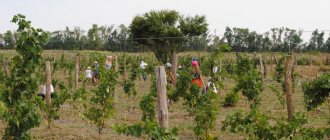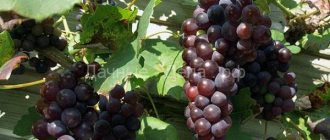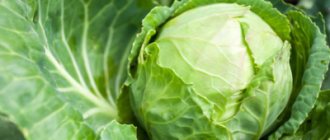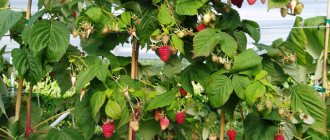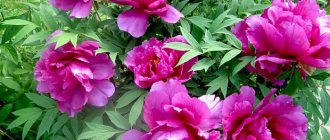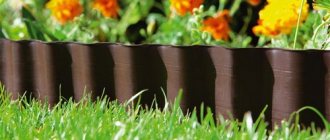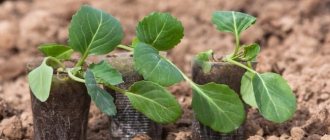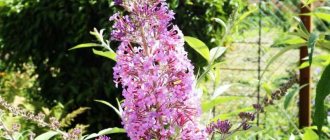Grape varieties - the best varieties for home cultivation
When choosing the best grape varieties for your home, you must take into account the climate in your region. The next important nuance is what goal you want to achieve when growing this crop. If for personal consumption taste qualities come first, then for the market it is presentation, the possibility of transportation and ripening time.
Rating of the best grape varieties
| Nomination | place | Name of product | rating |
| The best grape varieties for the Moscow region | 1 | Victoria | 5.0 |
| 2 | Tenderness | 4.9 | |
| 3 | Transfiguration | 4.8 | |
| 4 | Lowland | 4.7 | |
| 5 | Muscat Moscow | 4.6 | |
| The best early grape varieties | 1 | Anniversary of Novocherkassk | 5.0 |
| 2 | Tason | 4.9 | |
| 3 | Muscat summer | 4.8 | |
| 4 | Super Extra | 4.7 | |
| 5 | Beauty of the North | 4.6 | |
| The best mid-season grape varieties | 1 | Kishmish radiata | 5.0 |
| 2 | Rizamat is stable | 4.9 | |
| 3 | Augustine | 4.8 | |
| 4 | Lydia | 4.7 |
atya: https://womanadvice.ru/sorta-vinograda-samye-luchshie-sorta-dlya-domashnego-vyrashchivaniya
The best grape varieties
When studying the descriptions of grape varieties, every gardener wants to find a plant with ideal characteristics. Old table varieties are famous for their luxurious taste, but they have low winter hardiness and are susceptible to disease. Wine grapes have good sugar accumulation and high juice content, but they have small clusters and berries. The ideal option is to have several bushes for different purposes on the site. For beginners, we can recommend new complex-resistant hybrids and grape varieties with excellent frost resistance, taste and good data for the market.
The most delicious grape varieties
Kishmish radiata
Many lovers who describe delicious grape varieties include in their ratings the high-yielding and seedless Kishmish Radiant with an early-medium (up to 130 days) ripening period. The berries are dense, weighing up to 4 g, golden-pink or crimson, with a sugar content of up to 21%! Bunches - from 600 g to 1500 g. The taste of the grapes is harmonious with muscat notes.
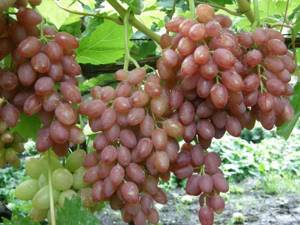
Grape variety Laura
The early grape variety Laura (second name Flora) ripens in 115-120 days. Large oval berries weighing up to 9 g have a salad-white color, the skin is tanned on the sunny side. Sugar content increases above 20%! with acidity up to 8 g/l, the aroma is pleasant with delicate nutmeg notes. With good care, Laura's bush produces a harvest of up to 40 kg.
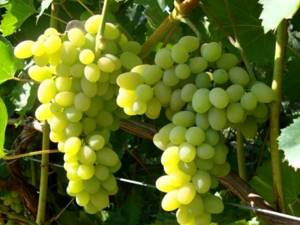
Rizamat
The Uzbek variety Rizamat was the king of the market before the advent of new hybrids. Its berries are large, pink, up to 14-15 g, with a sugar content of 22%! and an acidity of 6 g/l. Suitable for obtaining high-quality raisins, canning, and for the market. It has medium bunches - up to 1000 g. Disadvantages of the variety - low resistance to diseases, frost resistance - up to 18°C.
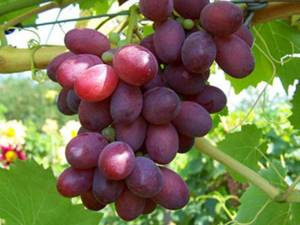
The best grape varieties for the market
Libya
If you are interested in early table grapes, transportable varieties for the market, then Libya is an excellent option. It has dense cylindrical clusters up to 1 kg or more, attractive pink egg-shaped berries with crispy and juicy pulp, a harmonious aroma with nutmeg notes. Frost resistance down to -21°C, growing season duration – 110 days.
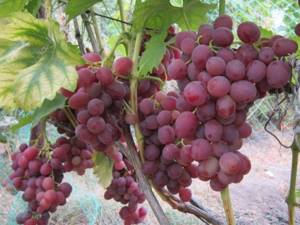
Anniversary of Novocherkassk
The popular variety was bred by amateur breeder N.V. Krainov. Its best qualities are excellent taste, huge bunches (from 800 g to 3 kg), stable yield, frost resistance down to -23°C. The Novocherkassky Jubilee berries have a harmonious taste, pink or yellowish-pink, up to 3.8 cm long, weighing up to 18 g.
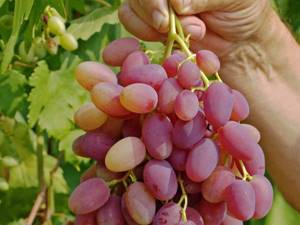
Arcadia
One of the most common and consistently productive early grape varieties with a growing season of up to 125 days. The clusters are large - from 500 g to 2 kg, the diameter of the berries is up to 2.3 cm. We note the good frost resistance of Arcadia (down to -24°C) and good resistance to disease. Its taste is simple; when fully ripe, a light nutmeg is felt.
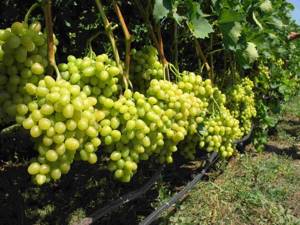
Early grape varieties
Anniversary of Kherson Summer Resident (YCD)
Ultra-early grape varieties are intended for production already in the last days of July; YuHD bunches are ready for sale at 100-110 days. The clusters of this grape variety are 500-600 g, the berries are large in size, beautiful dark pink in color, with a balanced taste and edible skin. It can withstand frost down to -26°C.
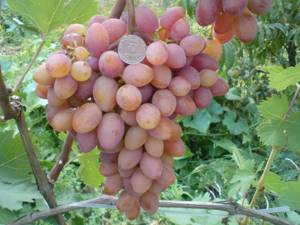
First-Called
Pervozvanny reaches technical ripeness on the 115th day of the growing season. Its clusters have a marketable appearance, grow up to 700 g, with an average density. The berry is amber-white in color with a harmonious taste, weighing up to 9 g, measuring up to 27x24 mm. The grape variety requires treatment with fungicides, but disease resistance is good, frost resistance down to -23°C.
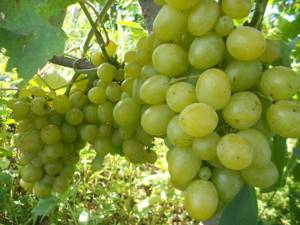
Super extra
The variety has marketable bunches up to 370-700 g with large berries up to 8 g and more. This grape has an amber color, an attractive appearance, and a harmonious taste. The advantages include early ripening (100-110 days), resistance to fungal diseases is above average. The Super-Extra grape variety can withstand frosts down to -24°C.
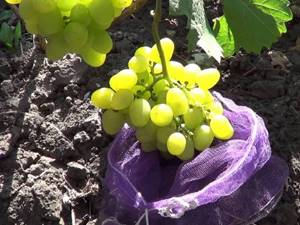
Frost-resistant grape varieties
Isabel
When listing frost-resistant grape varieties, lovers always mention Isabella, which can withstand cold temperatures down to – 30-32°C. It has long been used in winemaking and for fresh consumption. The distinctive features of Isabella include a pronounced strawberry flavor and slimy pulp. The berries are dark green in color, clusters up to 140 g. Ripening time - up to 180 days.
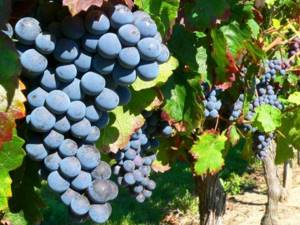
Amur grapes
This variety tolerates temperatures down to -40°C even in harsh northern regions. Its clusters weigh up to 240 g with black berries. The taste of the grapes is simple with sourness, sugar content reaches 19-23%! The variety is productive, is little affected by diseases, and can be used for the production of juice or compotes.
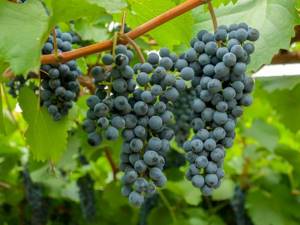
Amethyst
This grape has medium clusters, 270-300 g in size, reaching 700 g with a light load, the berry ripens in 110 days. It has increased frost resistance from -33 to -35°C. The taste of the Amethyst variety is sweet and sour, harmonious, with nutmeg and fruity undertones. The color of the berries is dark pink.

Grape varieties for wine
Chardonnay
When listing wine grape varieties, one cannot ignore Chardonnay, which produces chic drinks with notes of fruit, citrus and floral aromas. This Western European grape originated in Burgundy. The weight of an average bunch is up to 90-100 g. The berries of Chardonnay are white-green, tan, weighing up to 15 g. The growing season is up to 140 days.
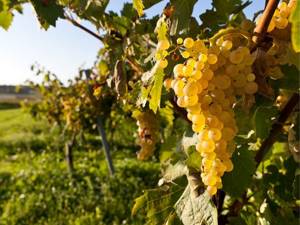
Sauvignon Blanc
Wine from Sauvignon gives off the aroma of currant leaves, herbs, fruits and gooseberries. It is often used for blending with Riesling and Aligote. The clusters weigh about 120 g, the berries are greenish-white, small to medium in size, with a pulp of harmonious taste. The duration of the growing season is up to 135 days.
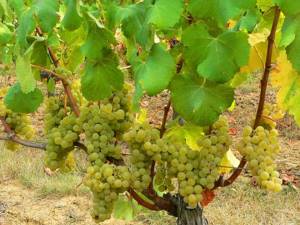
Pinot Noir
Used to produce elegant red wines with notes of herbs, berries and musk. The bunches of the Pinot Noir grape variety are small - up to 120 g, the berries are medium-sized with juicy and tender pulp, dark blue in color with a bluish bloom. The growing season is up to 150 days, so ripening occurs at the beginning of October or the end of September.
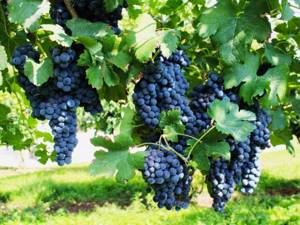
Cognac grape varieties
Aligote
When studying the question of what grape varieties cognac is made from, you will definitely come across a mention of Aligot. Its clusters are small, on average up to 100 g, the berry is up to 15 mm yellowish-green in color. The variety ripens in the south of Ukraine and Russia in the second half of September. The vine requires treatment for diseases, frost resistance down to -18°C.

Riesling
Grape variety of German origin with greenish-white berries, bunch weight up to 100 g. Ripens up to 150-160 days. Normally withstands cold temperatures down to -20°C. Riesling is not considered a high-yielding grape, but it makes excellent spirits with strong aromas of citrus, apples, honey, and wild herbs.
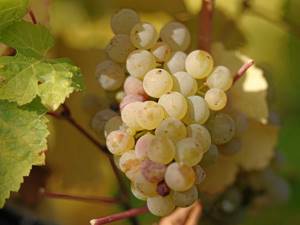
Bianca grape variety
A popular technical grape variety, the taste is harmonious and the flesh is juicy. In the southern regions it is ready for consumption in August. Bianchi's clusters are up to 120 g, berries are up to 1.5 g, yellow-green in color. Withstands frost down to -27°C, can hang on the vine for a long time, accumulating sugar content up to 28%!
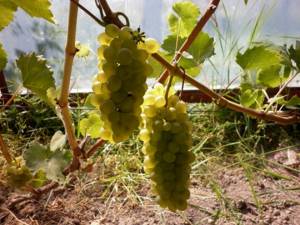
General recommendations and tips for growing grapes in a summer cottage
We choose a place on the site .
It is recommended that the place where the future vineyard will be planted be protected from the wind and located on the sunny side. There are no special requirements for soil cover, but if the soil at the dacha is salty or swampy (groundwater flows close), then it is better not to plant a vineyard. Please note that seedlings should be planted from the walls of the house with a distance of 1.5 m, from bushes by 3 m, from trees by 7 m. We plant grapes. There are two seasons for planting:
- spring – from April to May;
- autumn – from October until frost.
The hole should be approximately 80 cm deep.
- The first layer is 20 cm, it is advisable to apply fertilizers (grass, potassium, phosphorus, ash) and mix the fertilizers with the soil in a ratio of 1.5:2;
- The second layer is 20 cm, fertile soil, into which the roots of the seedling are lowered;
- The third layer is 40–50 cm, the earth is mixed with sand and filled to the top.
- Compact and water generously.
Vineyard care. After planting, the owner can only take care of the bushes and wait for large harvests.
- Prune the bushes back to only the three main stems.
- Apply organic or mineral fertilizers.
- Wrap up for the winter.
- Treat against pests and diseases.
By fulfilling all these conditions, you can get an excellent harvest of delicious grapes.
The best early grape varieties
Although the climatic conditions in the Moscow region are better than in the north, this area is still not particularly suitable for planting vineyards. This is due to the fact that June and half of July are usually hot here, and the second part of summer and early autumn are rainy. Because of this, the grapes crack and rot. To avoid this, it is better to plant early ripening varieties.
Anniversary of Novocherkassk
Rating: 5.0
The grape variety Jubilee of Novocherkassk occupies the first position in the ranking. It takes 110-120 days for the berries to ripen. The harvest is harvested at the end of summer. The bush grows strongly and is actively covered with large leaves. The weight of the bunches reaches 0.8-1.6 kg, and in rare cases up to 3 kg.
The berries are oval, oblong, yellow with pink. They look very attractive. Some bushes may have white berries with a pink tint or pure pink berries. The fleshy pulp is covered by a relatively dense skin. The taste of the grapes is harmoniously sweet, without any aftertaste. The riper the berry, the sweeter it is.
This grape variety has many positive reviews. Winegrowers note that it is resistant to frost (down to -23°C). He is not afraid of fungal diseases. Our experts included it in the rating because Novocherkassk Jubilee produces large, dense clusters. And strong grapes are perfectly transported and stored.
Advantages
- large bunches;
- sweetish harmonious taste;
- stable fruiting;
- berries are transported without problems;
- good disease resistance;
- frost resistance.
Flaws
- wasps love to attack this variety;
- requires normalization.
Tason
Rating: 4.9
The second place in the ranking was given to the Tason variety. It ripens in 100-110 days in the Moscow region, and in the south it is harvested already in mid-summer. The Tason grape bush is growing rapidly. It is covered with dark leaves that are formed from 5 lobes and have a strong dissection. The clusters are quite large (500-800 g), having a cylindrical-conical shape.
How to choose a good seedling
Experienced gardeners recommend not buying grape seedlings from unverified suppliers. It is better to trust the reviews of friends or your past experience. Not everyone has this opportunity, so when buying plants from a random seller, it is important to note the following points:
- seedlings for sale should not be stored outdoors, especially in sunny weather. There is nothing more destructive for a plant than an overdried root system;
- You shouldn’t rush the time to buy a seedling, but it’s better to wait for the mass sale. This is due to the fact that unscrupulous sellers can speed up the ripening of the vine. Such seedlings, while showing external signs of ripening, experience a deficiency of nutrients, which has a negative impact on their survival rate;
- if there are leaves on the additive, you need to look at their bottom plate. It should be clean and smooth. Irregularities and spots on the leaf most likely indicate the presence of itching;
- no need to buy autumn, lignified cuttings with leaves. Such a seedling quickly loses moisture and nutrients;
- if the “freshness” of a seedling is in doubt, you can check how alive it is. To do this, cut off up to 5 mm of the top. A good seedling has a juicy green cut. For the same purpose, you can lightly scrape the bark;
- good root system - dense, with strong, light roots. Cutting the roots also helps determine the condition of the seedling. The cut area should be moist, white or milky in color. Dark - brown or black color, indicates that the plant is dead;
- Having picked up the additive, you should bend it slightly. A fresh plant bends easily, producing a crackling sound;
- When purchasing a grafted additive, you should check how well the scion and rootstock have grown together. Holding the plant with one hand, you need to slightly bend the scion with the other. The connection point should be without gaps, with visible fusion along the entire circumference.
When buying grapes for planting, it is important to carefully check the seedling for compliance with all basic quality criteria. This is especially true when purchasing from random sellers. A seller of good, fruit-bearing and stable plants will always give a detailed answer to any questions and help with practical recommendations.
Strashensky
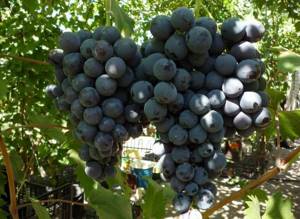
Strashensky. This view can be called exceptional. Thanks to its huge berries and equally huge bunches, gardeners have dubbed it the best grape variety. Although it is inferior to other species in frost resistance and disease resistance, the plant takes root well in arid climates and produces large yields. However, bushes are very bad at overloading. Largely due to the large mass of bunches. For this reason, their quantities must be controlled and, if possible, reduced. The berries grow the size of a plum. They have a highly saturated, almost black purple color.
2 1
